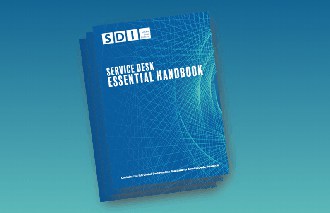
 By Sami Kallio, CEO, HappySignals
By Sami Kallio, CEO, HappySignals
In 2019, with a growing focus on the importance of employee experience in IT support, it’s finally time to understand the “bigger picture” – that while IT service desks need to be efficient, they also need to be truly effective in meeting business needs. Importantly, this “meeting of business needs” is not just in regimentally enacting IT service management (ITSM) processes and hitting perhaps arbitrary service level agreement (SLA) targets….
This blog explains how you can justify the use of employee experience measurement to not only improve the employee experience (of your service and support capabilities) but to also deliver greater value to the organization by increasing employee productivity.
Employee Experience is more than “Happy Employees”
While having happy employees is a truly great thing, more and more people are agreeing with Richard Branson’s view that:
“Clients do not come first. Employees come first. If you take care of your employees, they will take care of the clients.”
There’s more to employee experience than employee happiness with the work environment and everything it involves (including IT support). The latest Forrester research on employee experience reinforces that it’s multi-faceted, with the corporate IT capabilities playing a big part. This is best shown in the Forrester Employee Experience Index graphic below:
Source: Forrester, https://go.forrester.com/blogs/the-employee-experience-index/ (2019)
A quote from the same Forrester blog also offers a great definition of what better employee experience boils down to for most employees:
“Psychological research shows that the most important factor for employee experience is being able to make progress every day toward the work that they believe is most important.”
So, how well is your IT support organization enabling employees to “make progress every day toward the work that they believe is most important”? I’d be willing to bet that you probably don’t know right now….
The Adverse Employee-Productivity Impact of “Suboptimal” IT Support
It might be poor support, but I chose to call it “suboptimal” support because I don’t believe that anyone comes into work to do a bad job. Instead, think of this as many IT service desks being limited by what they know about their performance and the impact – both positive and negative – it has on the employees they serve.
I appreciate that most IT service desks will already operate some form of customer satisfaction mechanism – but how well does your customer satisfaction score reflect your performance? I could list a number of flaws with traditional customer satisfaction mechanisms (and how they offer up a false sense of security) but I think the image below will provide far greater insight into where many IT support organizations are right now. (And please appreciate that these values reflect both newer HappySignals customers, who are just starting out on their employee experience journey, and those who have already improved their service and support capabilities significantly).
Source: https://happysignals.com/happiness-score/
(based on 306k pieces of feedback over the last six months)
There are two very useful views of this employee experience data for your organization
Firstly, there are the overall employee experience scores – such as the average of +64 for happiness and 2h 57m lost productivity (as at the 13th May 2019), and the even higher scores achieved by our customers who’ve already significantly improved their employee experience. It thus offers up the scope for improvement on two levels – from getting to the average to then getting as good as you need to be.
Then secondly, there’s the channel-by-channel view shown above. Please note how poor the average self-service portal experience is – it has the lowest employee happiness score and employees lose more productivity (on average) than even with the email channel. It’s definitely not a great result from an IT-support investment that was made to speed up resolutions, improve the employee experience, and to ideally save costs.
Both of these views can be used to drive IT and business-level improvements.
Viewing Employee Experience from the Business Perspective
Here’s a quote from one of our customers that nicely articulates the “art of the IT-support improvement possible”:
“The lost productivity per ticket has now been going down month after month during last 6 months. Now in end of March 2019 our customers are losing on average 30min less time per ticket than they lost at the end of Q3 2018.”
This reduction in lost employee productivity over time can be quantified – and it’s where the business case for employee experience management often starts.
As employee experience increases, the lost productivity decreases – with a real business cost associated with that lost productivity. Our aggregated customer data to date shows that ten points in happiness equate to about an hour of lost productivity – and it works in either direction:
-
Increased happiness = greater employee productivity
-
Decreased happiness = lower employee productivity
Creating the Business Case for Employee Experience Management
This business case doesn’t need to be “War and Peace.” Instead, it can start as a one-pager that succinctly explains why employee experience measurement is important to your IT service desk and the wider organization, the costs of (as-a-minimum) trialing employee experience management, and the expected financial and non-financial benefits of doing so.
By showing either our aggregate data or customer success stories (or both if you prefer), it should be pretty clear to the reader that employee experience management is a great way of refocusing IT support costs from tickets, say USD 17 per ticket, to the lost employee productivity – which our customer data shows to be USD 170.
In the case of the customer-quote example above, that 30-minute saving would be something like USD 28 and nearly double the cost of handling the ticket in the first place. Plus, of course, the employees are ten-points happier with IT too.
Alternatively, you view this from a negative perspective. Let’s say that an IT cost reduction strategy has reduced the ticket handling cost by USD 1 and causes an increase in employee lost productivity of just 15 minutes (likely due to fewer available IT support staff), then this could cost the organization up to USD 14 per ticket in non-IT costs.
In fact, it might be that you first use employee experience management to defend the existing IT support budgets before then seeking to grow them in further optimizing the business value of the IT service desk.





























